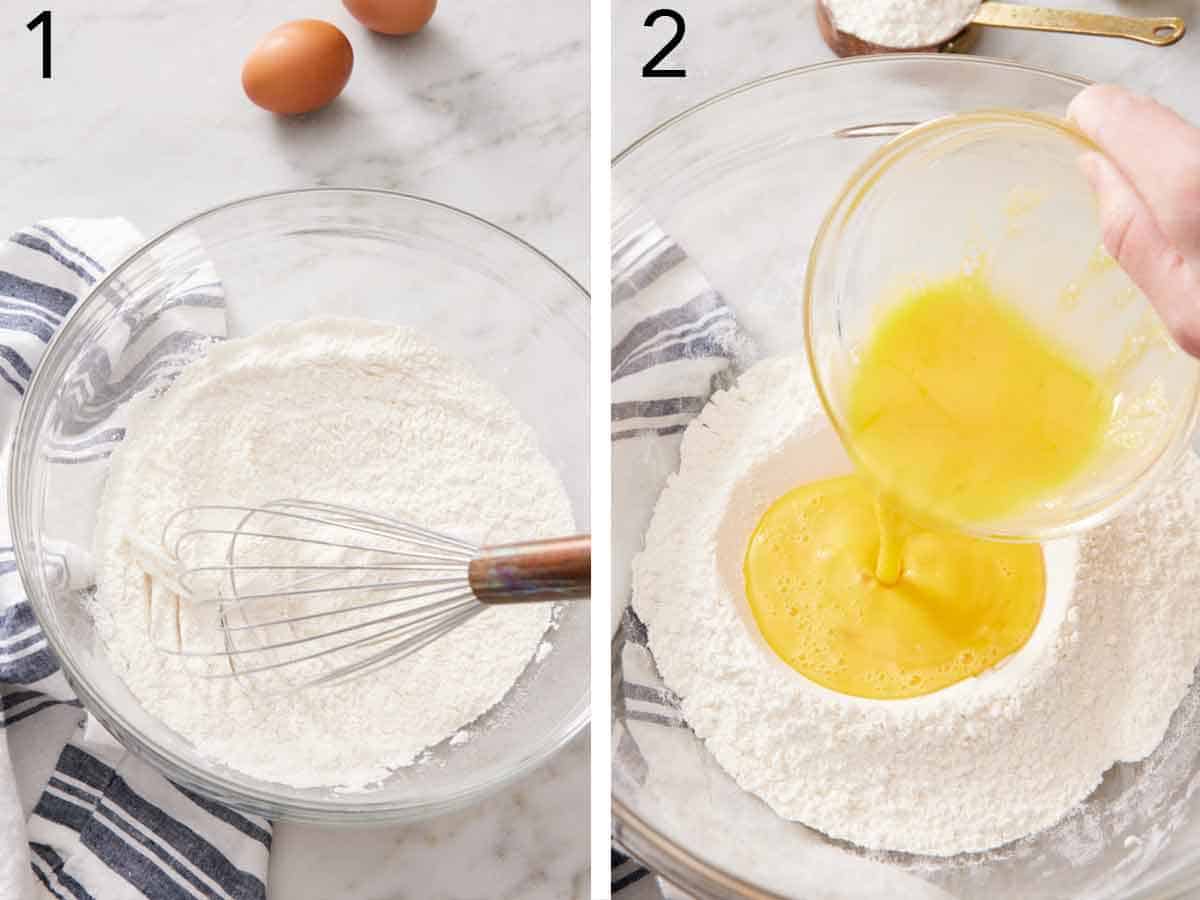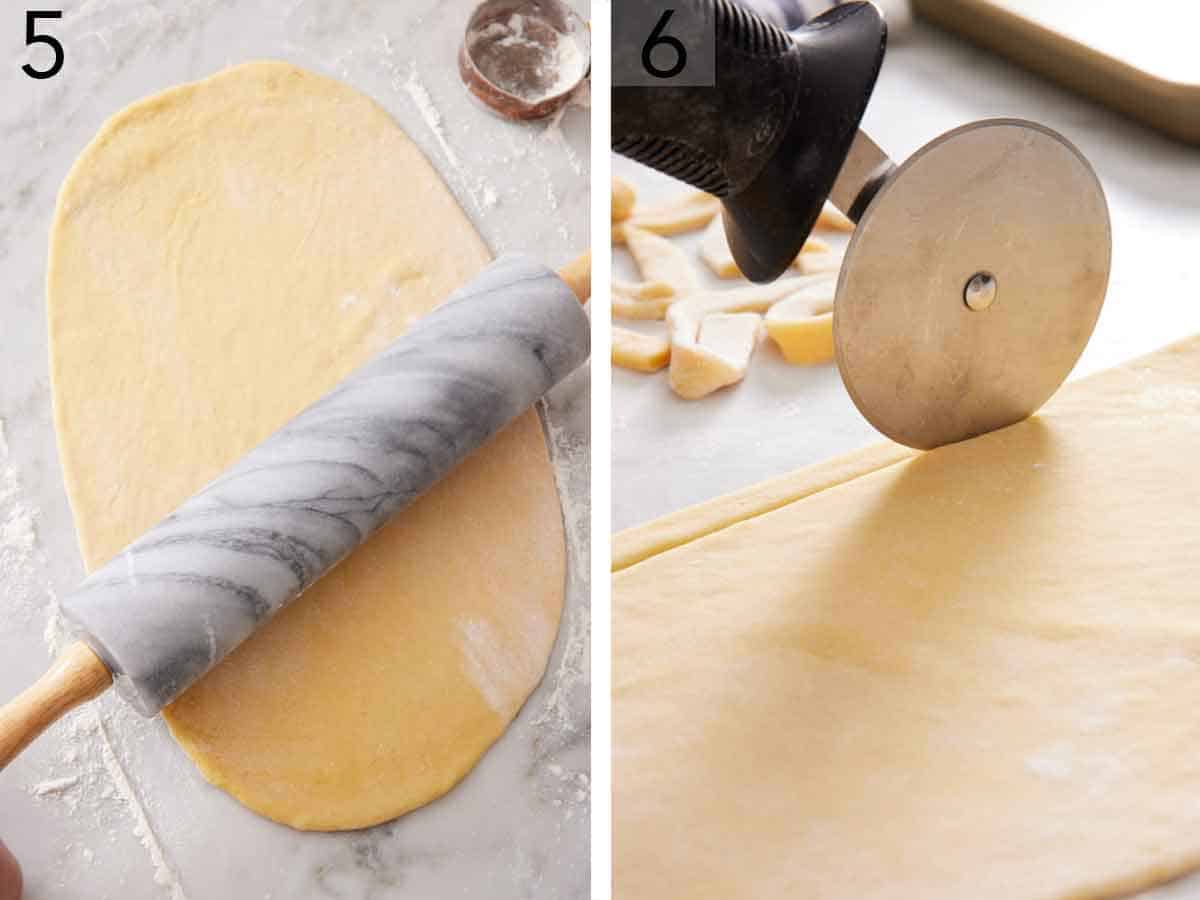You’ll never want to go back to store-bought pasta once you try these homemade egg noodles. They are perfectly tender with a fresh, savory flavor and elevate any dish you put them in. Unlike some recipes that call for just egg yolks, this recipe uses the whole egg, resulting in pasta that is tender, pliable, and flavorful.
The best part is that this recipe is fast enough to make for a weeknight meal, with easy prep and only 5 minutes of cooking time! Whether you make egg noodles to add to your favorite soup or enjoy them tossed in garlic, butter, and shredded cheese, this recipe will take your pasta dishes to the next level. For other homemade pasta recipes, try my homemade gnocchi, lobster ravioli recipe, or pasta dough recipe.
What You Need to Make This Recipe

Flour – I recommend using all-purpose flour. It makes the pasta noodles bouncy and yields a good chewy texture. Be sure to divide the flour as outlined in the recipe.
Eggs – for the best homemade noodles, use high-quality, large eggs at room temperature. The star ingredient in this homemade noodle recipe gives the pasta a rich taste, so opt for pasture-raised eggs if possible.
Milk – whole milk provides a buttery flavor and tender texture to the noodles. Be sure to bring it to room temperature before adding it to the recipe.
How to Make Egg Noodles

1. In a large bowl, stir together the flour and salt with a whisk.
2. In a small bowl, use a fork to beat the eggs. Use the whisk to make a well or circular indention in the center of the flour. Pour the eggs and milk into the well.

3. Use a fork to stir the egg mixture and the flour together until a dough starts to form.
4. Form the dough into a ball and transfer to a lightly floured work surface or counter. Knead the dough, adding the remaining ¼ cup of flour as needed, until the dough is mostly smooth and not sticky. Cover with plastic wrap and let it rest for 10 minutes. While the dough rests, bring a large pot of salted water to a boil.

5. Using a rolling pin, roll the ball of dough out on a lightly floured surface to ⅛-inch thickness.
6. Cut the rolled-out dough into desired-sized noodles with a pizza cutter or sharp knife.

7. Toss the cut noodles with a little more flour to keep them from sticking together.
8. Cook the noodles immediately in the salted boiling water until tender, about 3 to 4 minutes. Drain well. Serve immediately with your favorite sauce, in soup, or use in a stir fry.

Pro Tips For Making This Recipe
- Let the dough rest. Before rolling out the dough, allow it to rest covered in plastic wrap for at least 10 minutes. This makes the dough easier to roll out and gives the gluten a chance to rest, which prevents it from becoming tough in texture when overworked. You can wrap it tightly and let it rest for up to 4 hours before rolling.
- Roll the dough thin. Take into consideration when cutting the noodles that they will almost double in size while cooking. This also applies to the thickness, so make sure to roll the dough very thin, or the noodles will be too thick and very chewy.
- Lightly flour your surface. Only add enough flour to prevent the dough from sticking to the surface while kneading and rolling. You want the dough to remain soft but not crumbly from too much flour.
- Cook al dente. To give these noodles a delicious, hearty texture perfect for soups, stews, and salads, cook them al dente so they are still tender but firm and chewy. This should take about 3 minutes. If you want softer noodles, cook a few minutes longer.
- Salt the pasta water. Be sure to properly salt the water before bringing it to a boil to cook the pasta. It adds significant flavor to the pasta which also enhances the flavor of the dish you put them in. I recommend at least 1 tablespoon of salt for 12 cups of water.
- Use a pasta roller if desired. If you have a pasta roller and cutter, it makes the noodle-forming process much easier! Secure the pasta machine down to a sturdy surface and use it as directed.

Frequently Asked Questions
Fresh egg noodles should be cooked before eating, but depending on how you use them, you may not need to boil them first. To toss them with sauce or butter like regular pasta, cook them in salted boiling water as directed. To use in soups, if the soup is very brothy, drop in the fresh-cut noodles and cook them in the broth. If the soup is thick or creamy, I recommend boiling the noodles first, then stirring them in after the soup has finished cooking.
Serve these noodles with your favorite spaghetti sauce or add them to any recipe that uses egg noodles like chicken noodle soup, beef stroganoff, or turkey casserole. They are also delicious served simply with Swedish meatballs, topped with fresh parsley.
Yes, you can definitely freeze uncooked noodles to cook them later. Scatter the cut noodles on parchment paper and let them air dry so they do not stick to each other. Place them in the zip-top freezer bag and freeze them for up to 3 months. Boil from frozen in salted water until tender, about 5 minutes. I do not recommend freezing cooked noodles, as the water in the pasta will expand and make the texture very crumbly when defrosted.
Allow leftover cooked egg noodles to cool to room temperature before storing them in an airtight container in the refrigerator for up to 3-4 days. Heat noodles by placing them in a metal strainer and dipping them in boiling water for about 30 seconds until warmed all the way through.
If you’ve tried this Egg Noodle recipe, then don’t forget to rate the recipe and let me know how you got on in the comments below, I love hearing from you!

Egg Noodles
Equipment
- mixing bowl
- Rolling Pin
- Pizza cutter or sharp knife
- Large Pot
Ingredients
- 1½ cups all-purpose flour divided (180g)
- ½ teaspoon salt
- 2 large eggs beaten
- 2 tablespoons milk
Instructions
- In a large bowl, stir together the flour and salt, then make a well in the center. Add eggs and milk. Stir together with a fork to break up the eggs, then start stirring in the flour until a dough starts to form.
- Transfer the mixture to a lightly floured surface counter and knead the dough, adding the remaining ¼ cup of flour as needed, until the dough is mostly smooth and not sticky. Cover and let it rest for 10 minutes.
- While the dough rests, bring a large pot of salted water to a boil.
- Roll the dough on a lightly floured surface into ⅛-inch thickness and cut into desired-sized noodles with a pizza cutter. Toss the noodles with a little more flour to keep them from sticking together.
- Cook immediately in the salted boiling water until tender, about 3 to 4 minutes. Drain well. Serve immediately with your favorite sauce, in soup, or use in a stir fry.
Notes
- Let the dough rest. Before rolling out the dough, allow it to rest covered in plastic wrap for at least 10 minutes. This makes the dough easier to roll out and gives the gluten a chance to rest, which prevents it from becoming tough in texture when overworked. You can wrap it tightly and let it rest for up to 4 hours before rolling.
- Roll the dough thin. Take into consideration when cutting the noodles that they will almost double in size while cooking. This also applies to the thickness, so make sure to roll the dough very thin, or the noodles will be too thick and very chewy.
- Lightly flour your surface. Only add enough flour to prevent the dough from sticking to the surface while kneading and rolling. You want the dough to remain soft but not crumbly from too much flour.
- Cook al dente. To give these noodles a delicious, hearty texture perfect for soups, stews, and salads, cook them al dente so they are still tender but firm and chewy. This should take about 3 minutes. If you want softer noodles, cook a few minutes longer.
- Salt the pasta water. Be sure to properly salt the water before bringing it to a boil to cook the pasta. It adds significant flavor to the pasta which also enhances the flavor of the dish you put them in. I recommend at least 1 tablespoon of salt for 12 cups of water.
- Use a pasta roller if desired. If you have a pasta roller and cutter, it makes the noodle-forming process much easier! Secure the pasta machine down to a sturdy surface and use it as directed.















Leave a Reply